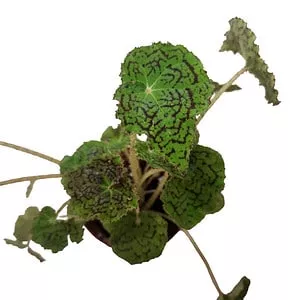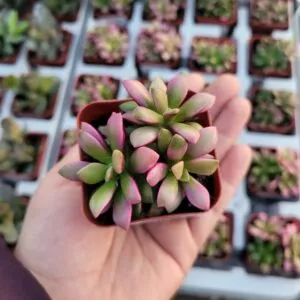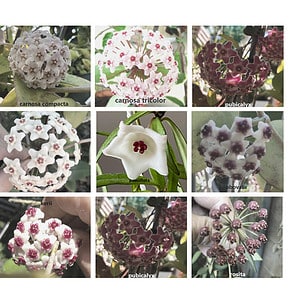No products in the cart.
Table of Contents
Hoya cumingiana has remarkable shrub-like foliage. This plant grows straight and does not tangle, unlike other Hoya species. The leaves are small, green, and waxy. It also produces pleasantly fragrant flowers.
This towering houseplant is an epiphyte and it’s native to Java, Borneo, and the Philippines. It implies that they grow on other plants and rely on the air for nutrition and humidity. Did it catch your attention? Read more below to find out more.

Hoya Cumingiana Plant Care Basics
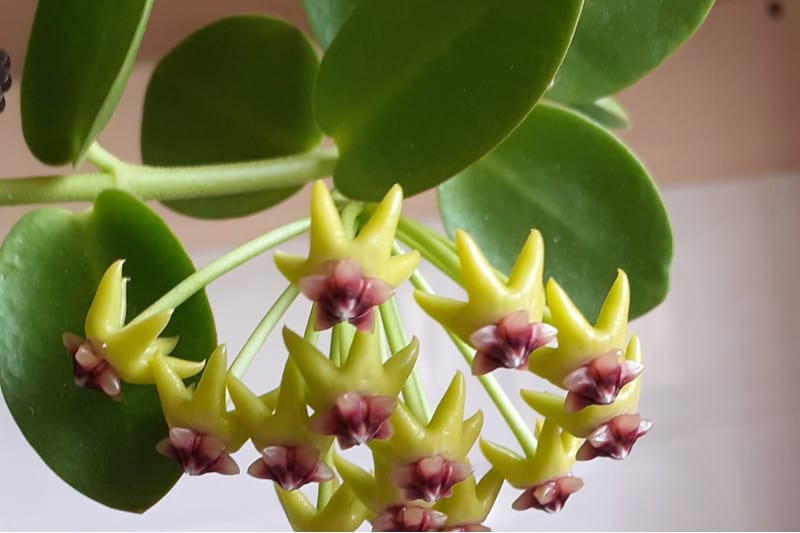
Have you had any Hoya species in the past? If yes, then, you’d know that plants under this genus are generally easy to grow. Hoya cumingiana is not an exemption. This plant wouldn’t give you much trouble. If you’re new to gardening, this plant is just right for you.
Soil
The most important thing to remember about soil requirements is that it has to dry fast. To achieve this, you’ve got to ensure that you properly mix the potting medium. A combination of perlite, cactus and orchid mix in equal proportion is will serve this purpose.
This soil mix is also applicable to other species of Hoya. You can check how well the drainage is by pouring water into the soil. If the water drains within a few minutes, then, the soil is well-draining. If you’re unsure, we recommend that you purchase the commercial mixes available in garden stores.
Keep in mind that Hoya cumingiana loves alkaline soil. More than having a well-draining property, the soil must have a pH range of 7.5 to 9.
Water
Now, in terms of watering, this Hoya needs only a medium amount. Your cue to water is when the topsoil gets completely dry. Drench the soil completely and let any excess water seep out of the pot’s holes.
It’s better to lean a little more on the dry side rather than chasing the dangers of overwatering. This wax plant has a succulent property. It means that they’re efficient in utilizing the water that they have.
Watch out when the plant starts showing droopy leaves. It’s possible that your plant is receiving more amount of water than it needs to. If it’s coupled with yellowing, then, take that as a red flag.
This condition could further lead to diseases. Pathogens are most active when the soil is always damp. Now if you want to avoid this, give your Hoya just the right amount of water. If you ever miscalculated, you can always let the soil dry as you wait for the plant to recover from water stress.
Light
 Bright light is something that your Hoya would love. But let me remind you that light exposure must be indirect especially if it’s grown outdoors. Give it around 30 to 50% partial shade. It would help to place it in a greenhouse if you have one. Or, you can use nets to serve as barriers against strong light intensities.
Bright light is something that your Hoya would love. But let me remind you that light exposure must be indirect especially if it’s grown outdoors. Give it around 30 to 50% partial shade. It would help to place it in a greenhouse if you have one. Or, you can use nets to serve as barriers against strong light intensities.
Indoors, this bush hoya will do well. If you have an east-facing window, that’s the perfect spot! Your plant would love to receive the morning sun. Indirect light exposure is possible in this setup. Window blinds and curtains are enough to give partial shade when needed.
Please never ever display your Hoya cumingiana under low light level conditions. It’s not an ideal place to be. Its foliage will turn pale green and sometimes, yellow. The production of flowers will also be delayed.
So, ensure that this houseplant receives everything it needs. It will surely reward you with lush growth and star-shaped blooms.
Temperature
Java, Borneo, and the Philippines are all tropical countries. Since Hoya cumingiana is a native of these places, you can expect that it likes warm climates. Preferably, a temperature range of 60 – 85 °F (15 to 23°C) will make the plant happy.
You’re lucky if you’re living in a location with this type of climate. That means growing Hoya will not be a trouble.
However, it’s going to be a huge problem if you have colder temperatures. This Hoya species isn’t frost or winter hardy. Once the temperature reaches below 50°F (10°C), your plant will experience damage to its tissues due to freezing and thawing. Don’t be surprised if your plant dies after the winter season.
Keep your Hoya plant indoors. You can just provide additional insulation during cold seasons. However, don’t expect that this is going to be an easy feat.
Humidity
By now you’d probably know that Hoyas require high humidity. Of course, it does! It’s a tropical plant, isn’t it? Maybe you’re thinking if this houseplant will grow in your place given an average humidity level. The good thing is that it can.
A sufficient level of moisture in the air helps the Hoya cumingiana grow well. If you’re having trouble with achieving high humidity, better purchase a humidifier to do the job. It’s a good investment especially if you’re keen on tending to houseplants that love humidity.
As a plant lover myself, I make sure I have an installed temperature and RH monitor at home. That helps me keep track of the growing conditions as well as watch out for fluctuations. That way I can have my Hoya and other houseplants ready for any possible stress.

Fertilizer
Monthly application of liquid fertilizer is already enough to sustain your Hoya cumingiana with the essential nutrients needs. Do this only during the growing season. Feed your plant with fertilizer high in phosphorus before the blooming time. This helps your Hoya produce more wax flowers.
Since the plant isn’t a heavy feeder, there are times when fertilizing isn’t needed at all. In fact, this epiphytic plant can take nutrients and moisture from the air with ease. In this manner, they’ll be able to look after themselves with little effort on your part.
If we want to help add nutrient sources, we should give it in minimal amounts. We don’t want to overfertilize our plants because the excess salts will hurt the roots.
Propagation
This wax plant grows on vines. Thus, the use of stem cuttings is the easiest method to propagate. You have three ways to root the cuttings. Either you use soil, water, or perlite.
How to Propagate in Soil?
- Finding a node is the initial step. Take about two-node stem cuttings from the plant.
- Ensure you’re using sanitized shears or cutters. Make the cut without injuring any of the plant’s healthy leaves.
- Place the cutting on moist sphagnum moss if you want it to root in the soil. Monitor the cutting for growth every few weeks.
- Transfer the cuttings into the potting mixtures when they produce enough roots.
How to Propagate in Water?
- To take cuttings, perform the same methods above. But instead of using soil, immerse the cutting in water.
- The process of water propagation is quick and straightforward. But you must replace the water every 2-3 days. Stagnant water promotes bacterial growth, which leads to root rot and oxygen deficiency.
- The leaves must never be submerged in water; only the node will be submerged.
- Search for a warm, well-lit area and place the water bottle.
- Repotting of the stems will be done once it has established itself to a good potting mixture.
How to Propagate in Perlite?
- This approach is highly effective for Hoya propagation. Perlite is a sterile element that allows a lot of air to pass through it. This helps to prevent root rot.
- Load a plastic container or tray with perlite to a depth of 1 inch. Allow the perlite to soak in the water for a minute. Drain any remaining water until the perlite is only slightly moist.
- Embed the stem in perlite; however, don’t bury the leaves.
- Choose a plastic bag with a few holes to cover the container.
- Place the container in bright, indirect sunlight. The temperature should be warm as well.
- Set it to a suitable potting mixture once the roots developed.
USDA Growth Zones
The most suited growing zones for outdoor cultivation of bush hoya are USDA hardiness zones 10, 11, and 12. Locations under these zones meet the conditions to successfully grow different Hoyas.
Potting
Repotting these outdoor plants should be done annually. Change the old soil mix with a fresh one. This helps the roots receive enough breathing room. It also helps encourage the regrowth of the plant’s entire foliage. Repotted hoya plants remain healthy and have a higher chance of producing fragrant flowers.
Pruning is not necessary unless the hoyas have been in their mature stage.
Hoya Species and Other Similar Plants
There are approximately 300-450 species of hoya plants. One of which is the bush hoya. Here are some examples of hoya species or varieties that are almost similar:
Hoya carnosa
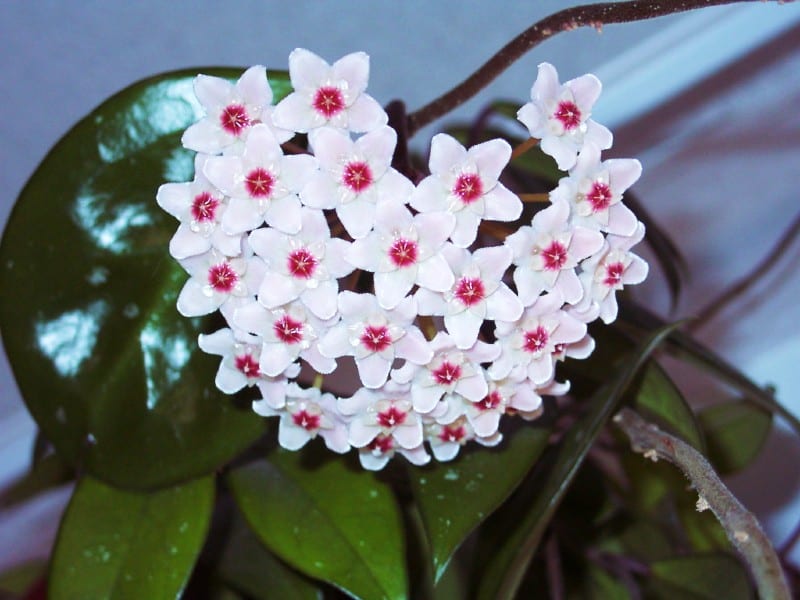
The primary (green) form of Hoya Carnosa is less common than many of its excellent hybrids (of which there is a ridiculous number). The foliage can be plain, variegated, crinkled, or otherwise textured. The blooms are long-lasting, fuzzy clusters of fragrant stars.
Hoya pubicalyx
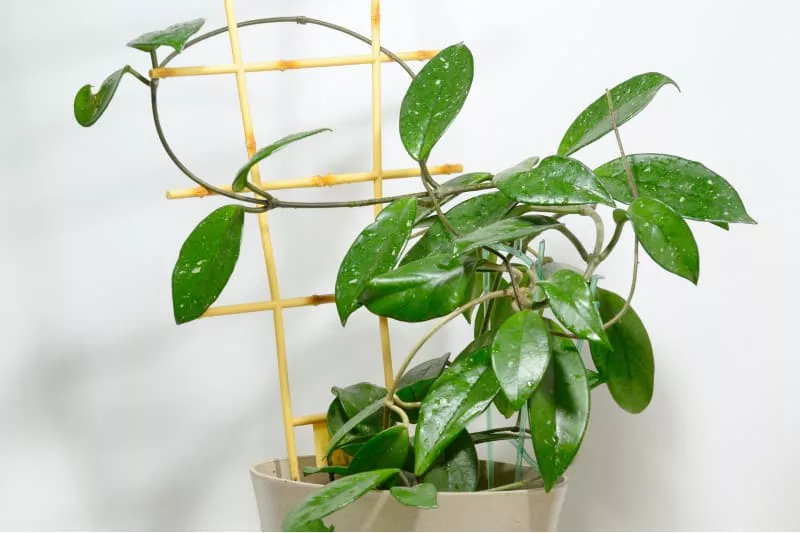
Pubicalyx is a hardy twining vine that can trail or climb, but it’s a little unruly: you may spend time unwinding the plant from its neighbors. It’s one of the fastest-growing Hoyas and very easy to propagate – just put a cutting in water.
Hoya kerrii

This plant, otherwise known as a Sweetheart Hoya or Lucky Heart, is commonly sold as a single, heart-shaped leaf planted in a small pot. The bright emerald green color of the cute, rounded leaves makes them popular St. Valentine’s Day gifts.
Hoya macrophylla
This large, rambling species is prized most especially for its waxy, light green, vein-patterned foliage. Their pointed oval leaves have an interesting 3-D texture. Prominent pale veins run longitudinally across a network of horizontally laid smaller veins.
Diseases & Pests
The Hoya cumingiana, on the other hand, is pest-resistant but can be attacked by pests. Mealybugs and aphids are the most common pests it encounters. Both of which are commonly found near star-shaped flowers.
Your plant is most likely infected with mealybugs if you notice a white waxy fluid on leaf joints or other hidden regions.
Use horticultural oils or synthetic sprays to get rid of them. Quarantining your houseplants for the first two weeks is the best approach to prevent them from spreading. This isolation will aid in the detection of pests and diseases.
Frequently Asked Questions
Hoya Cumingianas grow in humid conditions ranging from moderate to high. It can, however, withstand low humidity. Place it at a humidity level of 70 to 90 percent indoors. You don’t have to worry about moisture with this plant because it isn’t fussy about it.
Hoya plants come in various colors and sizes, with some preferring acidic environments and others not. Just a few coffee grounds will benefit the hoya kinds that thrive in acidic conditions.
However, coffee grounds should not be included in your feeding schedule if you work with alkaline soil-loving hoya plants like Hoya cumingiana or Hoya bella.
Spring and summer are the blooming seasons for Hoya cumingiana. Other hoya types might bloom multiple times throughout the year. Flowering can be hampered by various conditions, including a lack of light, improper pruning and watering schedule, as well as the plant’s age.
However, given with proper care, you may expect sweetly scented flowers every season.
Plantly offers high-quality hoyas that you can bring home. Hoya cumingiana is one of them. Don’t miss this chance and contact us now
Whether you want to buy, sell or simply reach out to other plant enthusiasts, Plantly is the right place to be!
In stock In stock In stock (can be backordered)
$12.00
Sold By:
PotHedz Plants
Begonia Decko Checks
Rated 4.96 out of 5 based on 106 customer ratings00
Sold By:
PotHedz Plants
$4.99
Sold By:
Plants by Stinky Boo
Anacampseros ‘Sunrise’ Succulent
Rated 5.00 out of 5 based on 2 customer ratings00
Sold By:
Plants by Stinky Boo
Free Shipping
$22.99
Sold By:
Gar-Zen Botanical Design
Petra Croton Ships Free
Rated 4.86 out of 5 based on 49 customer ratings02
Sold By:
Gar-Zen Botanical Design
$14.00 – $18.00
Sold By:
Beauties & Beasts
Hoya House Plant various species
Rated 4.83 out of 5 based on 24 customer ratings00
Sold By:
Beauties & Beasts
